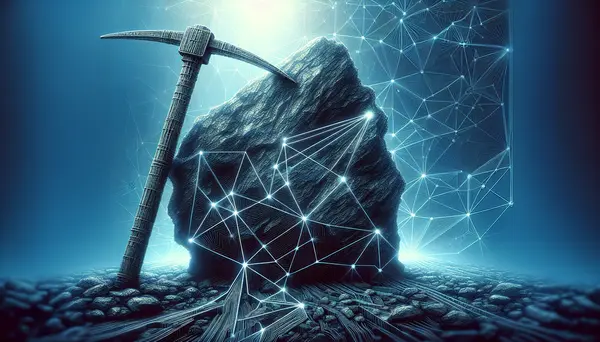Table of Contents:
Introduction to Ethereum Mining Difficulty
If you're interested in the world of cryptocurrency, then you've likely heard about Ethereum mining difficulty. But what exactly does it mean? And more importantly, how does it affect miners? In this article, we'll delve into these questions and provide a comprehensive understanding for beginners. We aim to demystify complex terms like 'Ethereum mining difficulty' and make them accessible for everyone.
Understanding Ethereum Mining
To comprehend the concept of Ethereum mining difficulty, let's first understand what Ethereum mining is. Simply put, Ethereum mining involves solving complex mathematical problems using computer hardware. The miner who solves the problem first gets rewarded with Ether (ETH), which is the native currency of the Ethereum network.
Get $500 free Bitcoin mining for a free testing phase:
- Real daily rewards
- 1 full month of testing
- No strings attached
If you choose to buy after testing, you can keep your mining rewards and receive up to 20% bonus on top.
Evaluation of Ethereum Mining Difficulty
| Pros | Cons |
|---|---|
| Provides an objective measure of the complexity involved in mining | Higher difficulty means less profitability for miners |
| Increases network security by protecting against spam attacks | Might discourage new miners due to the high difficulty to reward ratio |
| Motivates miners to upgrade their hardware to be more efficient | The need for high computational power might exclude miners with limited resources |
| Helps maintain the block time consistency | Fluctuation can make mining outcomes unpredictable |
The Role of Difficulty in Mining
Mining isn't as easy as just turning on your computer and waiting for ETH to roll in. There's an inherent challenge involved - that’s where ‘difficulty’ comes into play. The term 'Ethereum mining difficulty' refers to how hard it is to solve those mathematical problems mentioned earlier.
Determining Factors of Ethereum Mining Difficulty
A number of factors determine this level of difficulty:
- Total Network Hashrate: This represents the combined computational power being used by all miners on the network at any given time. When hashrate increases due to more miners joining or existing ones upgrading their equipment, so too does the overall difficulty.
- Block Time Target: Ethereum aims for a block time – i.e., how often new blocks are added –of approximately 15 seconds. If blocks are being mined faster than this target, the difficulty increases to slow things down. Conversely, if blocks are being mined too slowly, the difficulty decreases.
Impact of Ethereum Mining Difficulty on Miners
The level of Ethereum mining difficulty directly impacts miners in several ways:
- Rewards: A higher difficulty means that it's harder for individual miners or pools to solve a block and receive rewards. This can lead to lower profits unless offset by an increase in ETH price.
- Hardware Requirements: Increase in mining difficulty often necessitates more powerful hardware which could mean additional investment from miners.
Coping with Increasing Ethereum Mining Difficulty
Faced with increasing difficulties, what strategies can miners adopt? Here are some suggestions:
- Joining a Mining Pool: This is where multiple miners combine their computational power to stand a better chance at solving blocks and earning rewards. The earnings are then split among pool members based on contributed hashrate.
- Investing in More Powerful Hardware: If financially feasible, upgrading your equipment can help keep pace with rising difficulties.
Moving Forward as an Ethereum Miner
To succeed as an Ethereum miner today requires understanding how factors like Ethereum mining difficulty, network hashrate and block time targets affect your potential returns. It also involves staying adaptable – whether through joining mining pools or investing in new hardware when necessary - while keeping track of changes within the ecosystem such as shifts towards proof-of-stake consensus mechanisms (Ethereum 2.0).
In Conclusion...
Ethereum mining may seem daunting, especially with terms like 'Ethereum mining difficulty' floating around. However, once you understand the basics and how it impacts your potential profits as a miner, navigating this landscape becomes significantly easier.
Remember that while challenges exist in Ethereum mining due to increasing difficulties, there are also strategies available for coping. Stay informed about changes within the ecosystem and adapt accordingly - happy mining!
Frequently Asked Questions about Ethereum Mining Difficulty
What is Ethereum Mining Difficulty?
Ethereum mining difficulty refers to the measure of how hard it is to mine a new block for the Ethereum blockchain. Higher difficulty means it requires more computational power to find a solution.
Does Ethereum Mining Difficulty Affect Earnings?
Yes, higher Ethereum mining difficulty can mean less block rewards for miners, making mining less profitable.
How is Ethereum Mining Difficulty Calculated?
Mining difficulty is calculated based on the total computational power being used to mine Ethereum across the entire network at a given time.
Can Ethereum Mining Difficulty Be Predicted?
Ethereum mining difficulty can fluctuate based on the overall hashing power of the network, thus accurate predictions are hard to make.
How Does Ethereum's Proof-of-Stake Affect Mining Difficulty?
Once Ethereum fully transitions to Proof-of-Stake, Ethereum mining difficulty will become irrelevant as the concept of mining will be replaced by validating.






